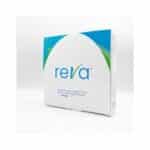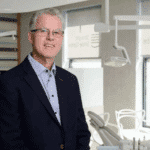by Rich Smith
Former Navy dentist Nicole M. Jane, DDS, MS, manages her practice with military precision and camaraderie
Let us establish right up front that Nicole M. Jane, DDS, MS, is a very personable orthodontist and that the dramatic growth of her Lake Tahoe, Calif, office is directly linked to her relationship-driven approach to running a practice.
“I make it a point to get to know every patient on a personal level,” says Jane, who currently sees approximately 50 of them during her customary 4-day workweek.
Of course, practitioner friendliness is only to be expected in a small community like Lake Tahoe—population 22,000, with only about 15,000 full-time, year-round residents—where an orthodontist making a trip to the grocery store or having a meal at the local eatery is always apt to encounter one or more patients. But, as Jane puts it, being able to casually chat with a patient who she has met outside the office and having the ability to remember who he is on sight and engage in conversation that extends beyond the mere exchange of pleasantries are the things that elicit good feelings and help deepen the bond between orthodontist and patient.
“It’s a big part of the reason why I’ve seen my referrals increase so dramatically in the short time I’ve been here,” she contends.
Positioned for Growth
In little more than 12 months, solo practitioner Jane’s income has doubled from where it stood when she took the practice off the hands of a long-established local orthodontist in late 2004. Her goal has been to build it into a $1 million-per-year enterprise by 2009. However, if she can maintain the current exuberant pace of new-patient starts, Jane thinks it might be possible to reach that mark sooner, possibly as early as 2007.
| Practice Profile | |
| Name: | Nicole M. Jane, DDS, MS |
| Location: | Lake Tahoe, Calif, and Gardnerville, Nev |
| Owner: | Nicole M. Jane, DDS, MS |
| Specialty: | Orthodontics |
| Years in practice: | 1 |
| Patients per day: | 50 |
| Starts per year: | 250 |
| Days worked per week: | 4 |
| Office square footage: | .Flagship,1,700; three satellites, 1,000–2,000 each. |
And Jane is well-positioned to do so, what with two satellite offices along the north shore of Lake Tahoe and a third across the state line in Nevada drawing patients from outside her immediate market area on the lake’s southern end.
“The satellites were put in place by the previous owner of the practice,” she clarifies. “When I bought the practice, they were included with the purchase.”
Jane visits the satellites in rotating order. She is in one of them for a full day every Monday and Friday between 10 am and 4:30 pm. When Jane is not present in those offices, other types of dental practitioners occupy them.
Her flagship is located on the upper floor of a 4,000-square-foot building that she owns. The building, with its typical Lake Tahoe charm, houses a general dentist on the ground floor and is situated along a well-traveled thoroughfare in an upscale neighborhood. Directly across the street is the office of a pediatrician; Jane’s practice signage is helpfully visible to parents bringing their kids to see that physician.
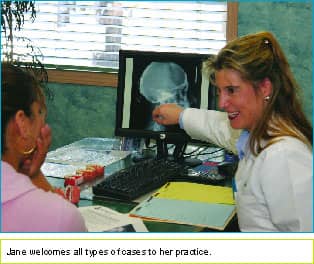
Jane also is known for her embrace of cutting-edge technology. For example, she is thought to be the only orthodontist in the Lake Tahoe area using a computerized imaging system that creates 3-D models of the patient’s teeth, both without and with braces. “This product allows me to determine ideal occlusion and aesthetics for the teeth, so that I can order robot precision-bent archwires,” she explains. “Because of that precision bending, the teeth move relatively quickly into exactly the position specified in the computer. It’s a very efficient way to treat. It eliminates all the little tweaking that normally has to be done toward the end of treatment, so it typically reduces treatment time by as much as 40%.”
To shorten per-visit chairtime, Jane uses self-ligating brackets. And, speaking of chairs, she recently yanked out the ones that came with the office and replaced them with state-of-the-art models featuring the finest cushioning available. “I believe patients should be made as comfortable as possible when they visit,” she says. “It’s just one more way to encourage them to keep coming back and to tell their relatives and friends about us.”
A Boatload of Lessons
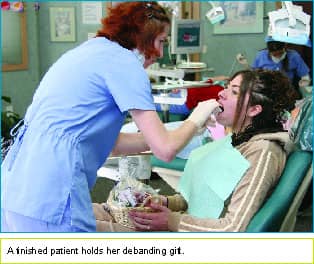
Jane went to sea following undergraduate studies at the University of Iowa (class of 1993) and dental schooling at the University of Michigan (class of 1998). She joined the Navy in 1996, midway through her postgraduate instruction.
“I had been paying my own way through dental school, but it eventually grew to be too much for me to financially manage,” she explains. “The Navy offered me a scholarship. By joining, I qualified for tuition plus a small stipend.”
The Navy also provided Jane with additional dental training once she formally donned the uniform in 1998. Afterward, she was assigned to duty as ship’s dentist aboard the USS Carter Hall, a troop transport vessel.
Jane left active duty in 2001 and officially ended her Navy career 3 years later, having attained the rank of lieutenant commander. Among the management habits she picked up during her time with the military was a reliance on standardized systems.
“I learned that systems need to be a priority in whatever practice setting you’re in,” she says. “Without them, everyone on your staff can be off doing his or her own thing—some of which may be productive and advantageous, but most of which will be the exact opposite. Standardization allows for team uniformity, for operational continuity—even as employees come and go.
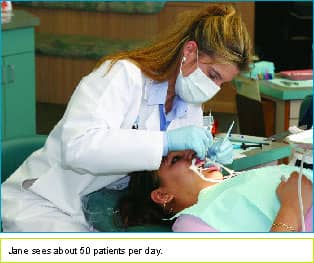
Jane stresses that her standard operating procedures are always considered to be works in progress. “They’re never really finalized,” she says. “We continually are finding opportunities to fine-tune them. And refinements have to be made every time we add a new technology, service, or process.”
Reading the Books
Another management technique that Jane learned through her Navy experience deals with audits. In the civilian world, failure to frequently audit a practice’s ledgers can tempt some employees to embezzle—especially true in offices where many patients pay with hard currency rather than by check or credit card, as was the case at Jane’s practice at the time she acquired it.
“A month after the ownership change was completed, my husband was reviewing the books and discovered discrepancies in how cash payments were recorded,” she recalls. “Some cash payments ended up being entered into the system as unpaid and uncollectible. In other instances, there were patients who didn’t even have accounts created for them.”
It took a while to straighten out the mess, but from then on Jane audited her books daily. “Every night I look at my numbers to make sure that the contracts, charges, and payments match the daily schedule,” she says. “It takes me about a half hour to do this, but it’s time well-spent.”
“The Learning Never Stops”
Navy crews typically have a set of obligations imposed on them over and above their normal assigned responsibilities. These are known as collateral duties, and Jane assigns them in her practice just as she did in the Navy. In that vein, each of Jane’s six employees heads a committee that oversees a vital facet of the practice, such as Occupational Safety and Health Administration compliance, policies and procedures development, or marketing.
“Taking on collateral duties gives the staff a sense that they are co-owners of the practice and invested in it being successful,” she says.
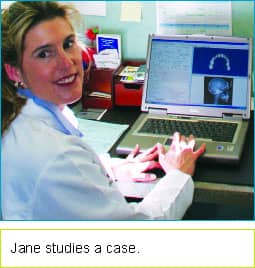
“Schedules fall apart. That’s always going to be the case, so you need to be flexible in order to minimize disruption and keep things moving ahead as smoothly as possible under the circumstances,” she says.
Thus, when cancellations produce unbridgeable gaps in the schedule, the staff fill the time by attending to their respective collateral duties, including working on goals Jane has set for each employee as a way of determining bonus pay. (The goals—or “benchmarks,” as Jane calls them—range from increasing new-patient starts to developing and implementing a patient-motivation program.)
No life in the military is complete without frequent drills, and while she wa s in the Navy, training was practically Jane’s middle name. Today, it still could be. “Training makes for a more efficient team, even as it helps the staff to operate in accordance with the systems that have been put in place, which is why we devote so much effort to training,” Jane offers.
Much of the training Jane provides to her staff is conducted in a learn-as-you-work manner. For example, at chairside, Jane explains to her assistant how she is performing a procedure—and why.
“I describe in detail what I’m looking at, what needs to be done in response to what’s there, and anything else I can think of that will help the staff become as knowledgeable as possible,” she says. “I also hold in-office seminars every other week. And, to gauge how well they’re retaining what I’m telling them, I often throw them some quiz questions. The point is, the learning never stops around here.”
The same can be said of the growth: The expansion of Jane’s patient base just doesn’t let up. At some point, of course, it must level off. But given the way things have shaped up for Jane, that might not happen until well past the point when her office is generating the income she expects. Which just goes to show: Money can’t buy you friends, but being friendly in a practice where relationships matter can certainly put you in the money. z
Rich Smith is a contributing writer for Orthodontic Products.
See Jane Succeed
When it came time to choose a practice location, top priority for orthodontic newcomer Nicole M. Jane, DDS, MS, was a place offering a great lifestyle rather than great demographics or growth potential.
An outdoors enthusiast from Midland, Mich, Jane at first sought to buy a practice along the shores of one of the Great Lakes. However, a purchase she lined up in a location there fell through, as did a second.
Her husband, originally from the San Francisco Bay Area, then suggested they try looking in California. Jane agreed, but insisted their search be limited to parts of the state with four seasons and that abutted a large body of water. That ruled out anywhere along the coastline, which has pretty much only two seasons: summer and not summer.
Among the few locations meeting Jane’s climatic and topographic criteria was Lake Tahoe.
Auspiciously, in addition to being a terrific place to live, Lake Tahoe also offered growth potential as a market somewhat underserved by orthodontists. Says Jane, “My first day in town, I stopped at the grocery store and, at the checkout stand, I told the cashier that I was an orthodontist just moving in. I couldn’t believe the reaction I got. She was so excited, and wanted me to know how very much the town needed someone like me, even though there were two other orthodontists already here. Still, I was very encouraged by the welcome she gave me.”
Patients appreciate Jane for many reasons, one of them being her ability to empathize. “I wore braces myself as a kid,” she says. “In fact, my teeth were so bad that I was treated using everything short of surgery. And I remember how I would study the mirror-like reflection in my orthodontist’s thick glasses as he worked on my mouth. I could see everything he was seeing. I thought all of this was really cool. Then and there I decided that orthodontics was what I wanted to do as a grown-up.”
Now that she’s grown and herself a practicing orthodontist, Jane has found activities outside the profession to further enthrall her. These include hiking, bicycling, and spinning (an aggressive form of gym workout conducted on a stationary bike). Her all-time favorite recreational pursuit is downhill skiing. “You can’t live in Tahoe and not be a skier,” she muses.
Jane is married to retired Marine James (Kevin) Bonner, who has children from a previous marriage (a daughter, Christina, 20, and a son, David, 19). Jane says at some point in the not-too-distant future she hopes to expand the family with a baby of her own. For now, her mothering of little ones is confined to the trio of Persian cats she owns (one is orange, another blue-cream, and the last black and white). For the record, the felines also think that Lake Tahoe is a terrific place to live, Jane says.
—RS





